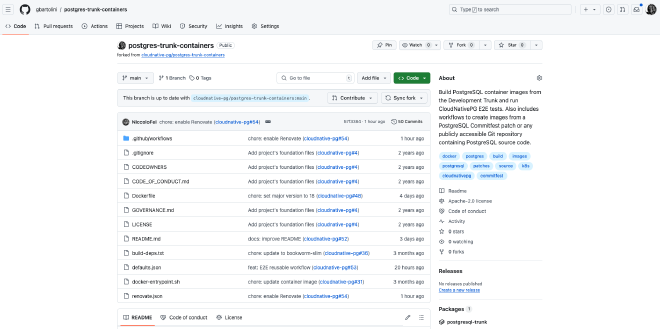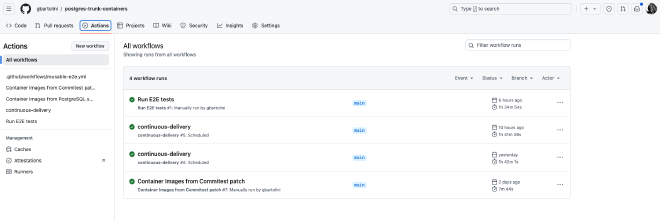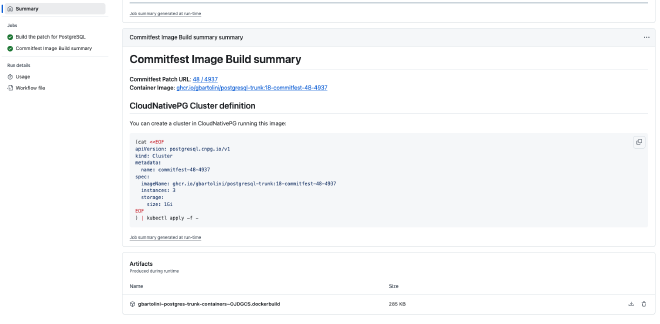How to test a PostgreSQL Commitfest patch in Kubernetes

Table of Contents
In this article, I’ll explore how Kubernetes and CloudNativePG can be leveraged to streamline the testing of PostgreSQL patches, especially during a Commitfest. By automating the creation of PostgreSQL container images from any public Git repository, developers and reviewers can quickly and efficiently test patches within a Kubernetes environment. This approach not only saves time but also enhances the reliability of patches before integration into the main codebase.
If you’re involved in developing PostgreSQL 18 and have some extra time, consider testing patches using Kubernetes with CloudNativePG. With just a few minutes of setup, you can leverage GitHub to fork a repository and build a container image directly from any public Git repo containing PostgreSQL sources. This allows you to harness the full power of Kubernetes to rigorously test and validate your PostgreSQL patches, ensuring they meet the highest standards before integration.
Background #
Traditionally, testing a PostgreSQL patch involves compiling it from source on
your local machine. However, this approach doesn’t translate well to a
Kubernetes environment due to container immutability requirements, which ensure
enhanced security. Typically, you would need to build the image on your laptop,
load it into a local registry, and then test it with Kind. While effective,
this method is often time-consuming, cumbersome, and demotivating.
I learned this the hard way when
testing a patch that disables ALTER SYSTEM,
and I vowed never to go through such a manual process again.
The “Postgres Patch Tester” Project #
Determined to streamline this workflow, I explored ways to improve it. During a conversation with my colleague Peter Eisentraut, a PostgreSQL core team member at EDB, he introduced me to an intriguing project: the “Postgres Patch Tester”. This tool is invaluable, as its associated Git repository contains branches automatically generated from patches submitted to the PostgreSQL hackers mailing list and registered on the Commitfest portal.
Each branch follows a specific format: commitfest/<COMMITFEST_ID><PATCH_ID>.
Here, COMMITFEST_ID corresponds to the Commitfest session number (e.g., 49
for
September 2024), and PATCH_ID
identifies the individual patch (e.g., 4937 for the patch titled
“Identify huge pages accessibility using madvise”).
Expanding the “Postgres Trunk Containers” Project #
Why is this important? At CloudNativePG, we maintain a Git repository called
postgres-trunk-containers,
which automatically builds a daily snapshot container image of the latest
PostgreSQL trunk (i.e., the master branch) and uses it to run our
comprehensive
end-to-end (E2E) test suite.
To clarify, the code currently on the trunk will become part of PostgreSQL 18
when it is released next year. This proactive approach allows us to quickly
identify and address breaking changes, regressions, or other issues, ensuring
that both CloudNativePG and PostgreSQL continue to evolve seamlessly.
Thanks to the collaborative efforts of my colleagues, Niccolò Fei and Jonathan Gonzalez, we’ve expanded the project’s scope to empower anyone with a GitHub account to build their own Postgres container images from source. This now includes support for a generic and publicly accessible Git repository containing PostgreSQL source code, allowing even Commitfest patches to be easily tested through the “Postgres Patch Tester” project.
Building Your First PostgreSQL Image from Source #
At CloudNativePG we’ve streamlined the process of building PostgreSQL container images with a fast and efficient GitHub action. You’re no longer restricted to the PostgreSQL trunk; you can now target any Git repository, branch, or specific Commitfest patch and have a PostgreSQL image ready to run with CloudNativePG within minutes. This setup facilitates quick and seamless patch testing in a Kubernetes cluster, including local environments using Kind.
To get started, fork the cloudnative-pg/postgres-trunk-containers repository.

Once you’ve done it, navigate to your forked repository’s “Actions” tab.
In the left panel, under “Actions,” select “Container Images from Commitfest Patch.” Next, click the “Run workflow” dropdown and fill out the form by specifying the Commitfest ID and the patch ID (you can leave the branch and PostgreSQL version fields empty). Finally, click the “Run workflow” button to begin building the container image based on the specified patch.
You can monitor the progress directly within the “Actions” GitHub interface; the process should take just a few minutes. Once the workflow is complete, the “Actions” page will look similar to this:

Click on the “Container Images from Commitfest Patch” job and scroll down to the bottom of the page. You should see an output similar to the screenshot below:

As shown, the workflow successfully built and published the image “ghcr.io/gbartolini/postgresql-trunk:18-commitfest-48-4937” in my GitHub “postgresql-trunk” container registry. Additionally, the action provides a basic set of instructions that we’ll use in the next section for testing this image in a 3-instance CloudNativePG cluster.
You can access all the images produced, including those from daily workflows that test the PostgreSQL trunk, via the “Packages” interface in your forked repository.
Testing the Patch with CloudNativePG in Kind #
If you’re familiar with CloudNativePG, you may have already created a cluster and started testing the patch in a Kubernetes environment. If not, don’t worry—you can use Kind (Kubernetes in Docker) right on your laptop, as explained in this section. I recommend going through CNPG Recipe #1 to understand the basics and prerequisites. Once you’re ready, follow the steps below to proceed.
First, create a basic Kind cluster with the following command:
kind create cluster
Next, deploy the latest non-production snapshot of the CloudNativePG operator:
curl -sSfL \
https://raw.githubusercontent.com/cloudnative-pg/artifacts/main/manifests/operator-manifest.yaml | \
kubectl apply --server-side -f -
Wait for the controller manager to start. Then, as the final step, create the
Cluster resource using the command provided in the action’s summary:
(cat <<EOF
apiVersion: postgresql.cnpg.io/v1
kind: Cluster
metadata:
name: commitfest-48-4937
spec:
imageName: ghcr.io/gbartolini/postgresql-trunk:18-commitfest-48-4937
instances: 3
storage:
size: 1Gi
EOF
) | kubectl apply -f -
Within a few minutes, you’ll have a 3-instance PostgreSQL cluster running in
your local environment. To connect via psql using postgres peer
authentication on the primary instance, use:
kubectl exec -ti commitfest-48-4937-1 -c postgres -- psql
If you want to access a shell to inspect the pod where PostgreSQL is running, type:
kubectl exec -ti commitfest-48-4937-1 -c postgres -- bash
There’s more … #
The Commitfest patch action is just one feature available. Another helpful action allows you to effortlessly create a PostgreSQL image from the patch you’re working on or reviewing: simply point to the branch containing the patch in any publicly accessible Git repository. With the “Container Images from PostgreSQL Sources” action, you can easily specify your Git repository and the relevant branch.
In just a few minutes, your custom image will be ready to deploy with CloudNativePG.
After building the container image, you can use the same repository to run end-to-end (E2E) tests, ensuring your patch is fully validated and production-ready. The “Run E2E tests” action allows you to specify the Postgres image to deploy within disposable CloudNativePG clusters, which are created as part of the E2E test suite. This comprehensive suite of tests—one of the most thorough for a PostgreSQL cluster (not just an instance)—takes just under 2 hours to complete.
Conclusions #
Leveraging Kubernetes and CloudNativePG for testing can significantly streamline the validation process of PostgreSQL patches, particularly those submitted during a Commitfest. This approach not only saves time and effort but also enhances the reliability of patches before they are integrated into the main codebase.
By automating the creation and testing of PostgreSQL images, we aim to free developers from the complexities of manual testing, allowing them to focus more on creativity and innovation. Each patch will benefit from approximately 200 automated tests running on a 3-instance PostgreSQL cluster within Kubernetes rather than on a single instance. These tests cover critical areas such as backup, recovery, automated failover, switchover, monitoring, logging, upgrades, and more.
I hope this initiative proves valuable and is well-received by the PostgreSQL developer community. Additionally, I hope it encourages more developers to explore Kubernetes and Cloud Native technologies, helping us all stay at the forefront of database innovation.
I would greatly appreciate your feedback! Thank you!
Stay tuned for the upcoming recipes! For the latest updates, consider subscribing to my LinkedIn and Twitter channels.
If you found this article informative, feel free to share it within your network on social media using the provided links below. Your support is immensely appreciated!
Cover Picture: “Elephant Trunk“.